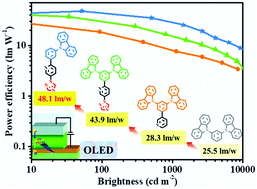当前位置:
X-MOL 学术
›
J. Mater. Chem. C
›
论文详情
Our official English website, www.x-mol.net, welcomes your
feedback! (Note: you will need to create a separate account there.)
Molecular evolution of host materials by regular tuning of n/p ratio for high-performance phosphorescent organic light-emitting diodes†
Journal of Materials Chemistry C ( IF 5.7 ) Pub Date : 2018-06-28 00:00:00 , DOI: 10.1039/c8tc02432d Di Liu 1, 2, 3, 4, 5 , Fang Wang 3, 4, 5, 6 , Ruijuan Yao 1, 2, 3, 4, 5
Journal of Materials Chemistry C ( IF 5.7 ) Pub Date : 2018-06-28 00:00:00 , DOI: 10.1039/c8tc02432d Di Liu 1, 2, 3, 4, 5 , Fang Wang 3, 4, 5, 6 , Ruijuan Yao 1, 2, 3, 4, 5
Affiliation

|
By linking pyridine and 1,2,4-triazole as an electron-deficient group, two “dual n-type unit” bipolar host materials, namely 2-(3,5-di(9H-carbazol-9-yl)phenyl)-5-(1H-triazol-1-yl)pyridine (PyTzDCz) and 2-(3-(9H-carbazol-9-yl)phenyl)-5-(1H-triazol-1-yl)pyridine (PyTzSCz), and one bipolar reference compound 2-(3,5-di(9H-carbazol-9-yl)phenyl)pyridine (PyDCz) were designed and synthesized for use in phosphorescent organic light-emitting diodes (PhOLEDs). From the parent 1,3-bis(9H-carbazol-9-yl)benzene (mCP) via PyDCz and PyTzDCz to PyTzSCz, the molar ratio of n-type pyridine/triazole to p-type carbazole was regularly tuned as 0 : 2, 1 : 2, 2 : 2, and 2 : 1. With a regular increase of n/p ratio from 0 : 2 gradually to 2 : 1, the LUMO levels of these hosts are regularly deepened to enhance electron injection, and the turn-on voltages of their blue and green PhOLEDs are regularly decreased. Particularly, the PyTzSCz-hosted blue PhOLED turned on at 2.6 V with high power efficiency of 48.1 lm W−1 (corresponding to an external quantum efficiency of 26.4% and a current efficiency of 45.9 cd A−1), which is the lowest turn-on voltage so far and one of the highest power efficiencies reported for FIrpic PhOLEDs containing a single host. The PyTzSCz-hosted green device also exhibited low turn-on voltage of 2.4 V and high external quantum efficiency of 28.0%. This study manifests the molecular evolution trend of host materials from hole-transporting via bipolar to “dual n-type unit bipolar” for performance optimization.
中文翻译:

通过定期调节n / p比率可实现高性能磷光有机发光二极管主体材料的分子进化†
通过连接吡啶和1,2,4-三唑作为缺电子基团,两种“双n型单元”双极主体材料,即2-(3,5-二(9 H-咔唑-9-基)苯基)-5-(1 H-三唑-1-基)吡啶(PyTzDCz)和2-(3-(9 H-咔唑-9-基)苯基)-5-(1 H-三唑-1-基)吡啶(PyTzSCz)和一种双极性参考化合物2-(3,5-二(9 H-咔唑-9-基)苯基)吡啶(PyDCz)设计并合成用于磷光有机发光二极管(PhOLED)。从母体1,3-双(9 H-咔唑-9-基)苯(mCP)通过在PyDCz和PyTzDCz与PyTzSCz之间,n型吡啶/三唑与p型咔唑的摩尔比通常调整为0:2、1、2:2、2:2和2:1。从0:2到2:1的比例逐渐增加这些主体的LUMO含量,以增强电子注入,并定期降低其蓝色和绿色PhOLED的开启电压。特别是,承载PyTzSCz的蓝色PhOLED在2.6 V时开启,具有48.1 lm W -1的高功率效率(对应于26.4%的外部量子效率和45.9 cd A -1的电流效率),这是迄今为止包含单个主机的FIrpic PhOLED的最低开启电压,也是报道的最高功率效率之一。PyTzSCz托管的绿色设备还具有2.4 V的低启动电压和28.0%的高外部量子效率。这项研究表明了基质材料的分子演化趋势,即从空穴通过双极传输到“双n型单元双极”以优化性能。
更新日期:2018-06-28
中文翻译:

通过定期调节n / p比率可实现高性能磷光有机发光二极管主体材料的分子进化†
通过连接吡啶和1,2,4-三唑作为缺电子基团,两种“双n型单元”双极主体材料,即2-(3,5-二(9 H-咔唑-9-基)苯基)-5-(1 H-三唑-1-基)吡啶(PyTzDCz)和2-(3-(9 H-咔唑-9-基)苯基)-5-(1 H-三唑-1-基)吡啶(PyTzSCz)和一种双极性参考化合物2-(3,5-二(9 H-咔唑-9-基)苯基)吡啶(PyDCz)设计并合成用于磷光有机发光二极管(PhOLED)。从母体1,3-双(9 H-咔唑-9-基)苯(mCP)通过在PyDCz和PyTzDCz与PyTzSCz之间,n型吡啶/三唑与p型咔唑的摩尔比通常调整为0:2、1、2:2、2:2和2:1。从0:2到2:1的比例逐渐增加这些主体的LUMO含量,以增强电子注入,并定期降低其蓝色和绿色PhOLED的开启电压。特别是,承载PyTzSCz的蓝色PhOLED在2.6 V时开启,具有48.1 lm W -1的高功率效率(对应于26.4%的外部量子效率和45.9 cd A -1的电流效率),这是迄今为止包含单个主机的FIrpic PhOLED的最低开启电压,也是报道的最高功率效率之一。PyTzSCz托管的绿色设备还具有2.4 V的低启动电压和28.0%的高外部量子效率。这项研究表明了基质材料的分子演化趋势,即从空穴通过双极传输到“双n型单元双极”以优化性能。











































 京公网安备 11010802027423号
京公网安备 11010802027423号